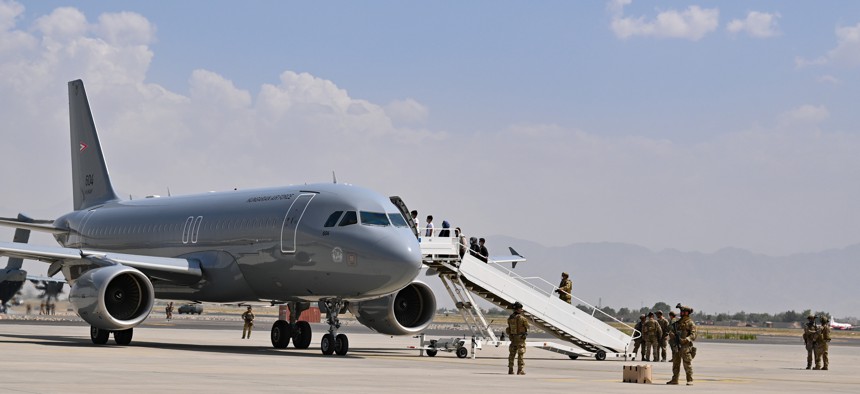
Paratroopers assigned to the 1st Brigade Combat Team, 82nd Airborne Division, based out of Fort Bragg, N.C., facilitate the safe evacuation of U.S. citizens, Special Immigrant Visa applicants, and other at-risk Afghans out of Afghanistan as quickly and safely as possible from Hamid Karzai International Airport in Kabul, Aug 22. U.S. Central Command Public Affairs
Almost Hijacked? Officials Dispute Scare Amid Ongoing Afghanistan Evac
While the chaos at HKIA is over, the effort to evacuate Afghans is not. Here’s how the U.S. is still getting people out.
Update: This article was updated after its original publication to include new statements from U.S. Central Command.
The State Department estimates that “a couple thousand” additional evacuees have been able to depart Afghanistan since Aug. 31, as a rare pairing of Biden administration staff and private organizations try to finish the work of the largest, most chaotic, and most dangerous emergency airlift in U.S. history.
“It’s wild that the State Department and DOD are doing this,” said one of the volunteers, a veteran who is in regular meetings with those government officials to keep the evacuation going, through his role in the #AfghanEvac coalition. “It’s the most American thing I’ve ever seen.”
In all, about 100 private groups—many of them run by Afghanistan veterans who spoke out about the chaos and broken promises created by the Aug. 31 deadline—have stuck around to finish the job. And they are getting support from DOD and the State Department to do so.
The ongoing effort to evacuate has occurred as additional details from those two chaotic weeks leading up to the Aug. 31 withdrawal have begun to surface.
A signature image of the chaotic 17-day evacuation of Hamid Karzai International Airport was a departing C-17 mobbed by Afghans who hung on as it took off. But other aircraft were in similar straits that day, Air Force officials revealed in a statement on Wednesday.
Two HC-130J Combat King II aircraft on the ramp were about to be swarmed when they “took off on a sliver of remaining runway. With seconds to spare, they were airborne skimming just 10 feet above the crowd.”
Days later, U.S. forces holding the airport stopped five people aboard a commercial airliner. They “intended to hijack the aircraft,” the Air Force also revealed in that statement.
“Our team worked to get them clear of the NATO ramp, relocated to the north side away from friendly forces, then ultimately onto the south side where the situation was handled.”
But on Thursday, officials at U.S. Central Command said there had been no attempted hijacking, even though the Air Force's statement that described people who "intended to hijack the aircraft" had been reviewed by CENTCOM.
“This article has been thoroughly reviewed for operational security by U.S. Central Command as of Oct. 6, 2021,” the Air Force wrote at the bottom of the original release.
What actually happened, CENTCOM spokesman Capt. Bill Urban said in a statement, was that “during the Afghanistan evacuation mission, an intel tip indicated the possibility of a plot to hijack a particular commercial flight that was preparing to depart the airfield. Ground traffic controllers diverted the plane to a safe location on the airfield where security forces boarded the plane and determined that there was no active attempt to hijack the aircraft.” Urban did not confirm or deny that five suspects were stopped by U.S. troops or whether they intended to attempt a hijacking, as the Air Force reported.
The chaos extended outside the gates, where many of the same veterans groups now working with the State Department and DOD had scrambled to charter flights and in some cases, flown to Afghanistan themselves to rescue the commandos, interpreters, and other Afghan staff who had helped them during their deployments.
During the two weeks of chaos, many of those groups were working largely on their own, the Air Force said in its Wednesday narrative summarizing the days and weeks leading up to Aug. 31.
As airmen worked the gates at HKIA, “a simultaneous effort by retired veterans, contractors and former instructors of Moody AFB's 81st Fighter Squadron were stateside working tireless operations to help get the Afghan Air Force pilots and maintainers—who had lived and trained in south Georgia—safely from Afghanistan,” the Air Force said.
“They took photos of the wall of graduates to provide photos with names to the [Personnel Recovery Task Force] and Marines running security. Community leaders and congressional staff members helped them successfully get U.S. visas. The process wasn't smooth nor without catastrophe, but after many attempts and controlled movements, they were evacuated to other locations.”
While 124,000 Americans and Afghans were flown out by the Aug. 31 deadline, thousands more were stranded, which left many of the groups raw. But they also went back to work.
Joint Chiefs Chairman Army Gen. Mark Milley hosted the first group meeting shortly after the last U.S. troops departed. He was joined by a State Department staff member who had just departed Hamid Karzai International Airport as part of the evacuation team, and Defense Department staff.
Those meetings are still going on and will continue as the groups keep raising money and pooling information and resources to get Afghans out, the veterans groups and State Department officials said. Since Aug. 31, the couple thousand Afghans who have gotten out have done so via land routes and in a few cases, through chartered flights. Their departures are aided by the volunteer groups, many of whom have now coalesced under the #AfghanEvac coalition.
The groups will likely never be reimbursed for the millions of dollars they have raised and spent on flights to get Afghans evacuated, nor are they asking for that repayment, said the veteran, a member of the coalition.
But at least one Congressional staffer thinks the groups should be repaid.
“It would make sense for State to do [repay the groups] and would be right, since they are doing State’s job for them,” the staffer said on the condition of anonymity.
The larger coalition group holds planning calls three times a week to share what’s working and what’s not. It’s composed of scores of those original Afghanistan rescue veterans organizations, including Task Force Pineapple, Digital Dunkirk, Allied Airlift 21 and others who fought to get their interpreters and commandos inside HKIA.
Then a smaller group of those veterans meet twice a week with State and Defense Department staff to share what they’re hearing and get help working departure issues such as hunting down required paperwork, advising on the status of border crossings over land, getting charter flight landing rights and getting aid.
One of the first tasks the group took on was getting everyone to adopt the same data format. For weeks, thousands of passport photos, Excel lists of names, and photocopies of employment records had been shuttled across the internet as each individual rescue organization tried to get their people through the gate. Now those names are centralized and secured at HumanRightsFirst.org.
But other obstacles remain. Outgoing flights are limited to daylight hours because of a lack of civic infrastructure at HKIA. No one can be cleared to board unless they can get past Taliban security checkpoints. Nor can a plane depart until all passengers are matched to the manifest, and permission to land has been secured, with State assistance, from a receiving country, two of the veterans said.
“No one person is saving anybody,” the Navy veteran said. “This is a group effort all the way through.”







